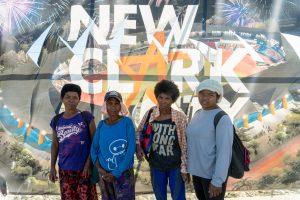To decongest the densely-populated Metro Manila and create opportunities in the northern Philippines, the Bases Conversion and Development Authority (BCDA) began the construction of the initial phase of New Clark City (NCC), a 9,450-hectare smart city, in January 2018 in the hills of Capas town in Tarlac province.
The “multi-billion dollar” project, which is one of the flagship infrastructure projects of President Rodrigo Duterte’s Build, Build, Build program, aims to entice foreign investors to set up businesses in NCC.
But the construction threatens to displace at least 65,000 people from 12 villages, including some 18,000 indigenous people who belong to the Aeta tribe.
At least 300 families were evicted when a sports complex in the Phase 1-A of NCC was built. The massive sports complex includes a stadium, an aquatic center, and an athlete’s village where delegates to the 2019 Southeast Asian Games were housed.
On December 2, 2019, at least 500 families from the Aeta tribe in Aranguren village in Capas town were given a seven-day notice to evacuate from their lands to make way for the construction of the access road from NCC to Clark International Airport.
The letter states that the tribe is living on government-owned land located in the Clark Special Economic Zone.
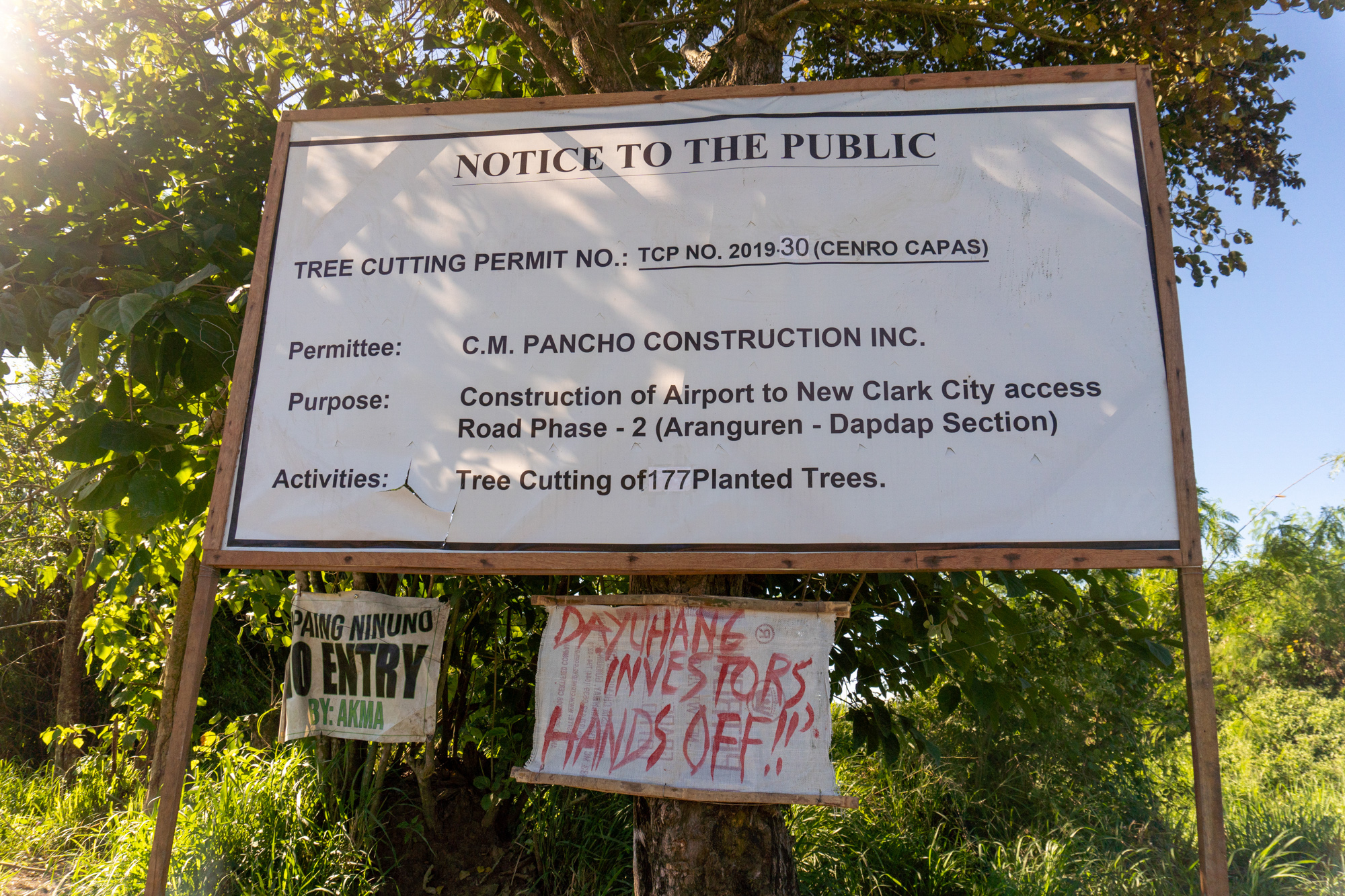
Aetas hang signs below another sign that shows the approval of the cutting of 177 planted trees to construct New Clark City’s access road to the airport. The sign put up by Aeta reads “Ancestral Land, No Entry” while the other sign says “Foreign investors, hands off!!” Photo by Bernice Beltran.
In March 1992, the late former president Cory Aquino signed into law the Bases Conversion and Development Act of 1992 or BCDA. It is a government corporation that was formed to take over and manage base lands that the U.S. Army abandoned. The law, however, does not say anything about the indigenous people living within the former military base and military reservations.
Since time immemorial, the Aeta tribal people have been living in the hinterlands of the region, north of Manila.
Tribal chieftain Petronilla Capiz Munoz, known to her family as “Apung Pet,” said that her ancestors had been in Capas town long before the BCDA was formed in 1992.
In fact, they were here “long before the Spanish came,” Apung Pet added. She and her family live in a tribal community called Sapang Kawayan, literally meaning Bamboo Creek, in Aranguren village.
Apung Pet claimed their clan inherited some 8,000-hectares of ancestral land from their forefathers.
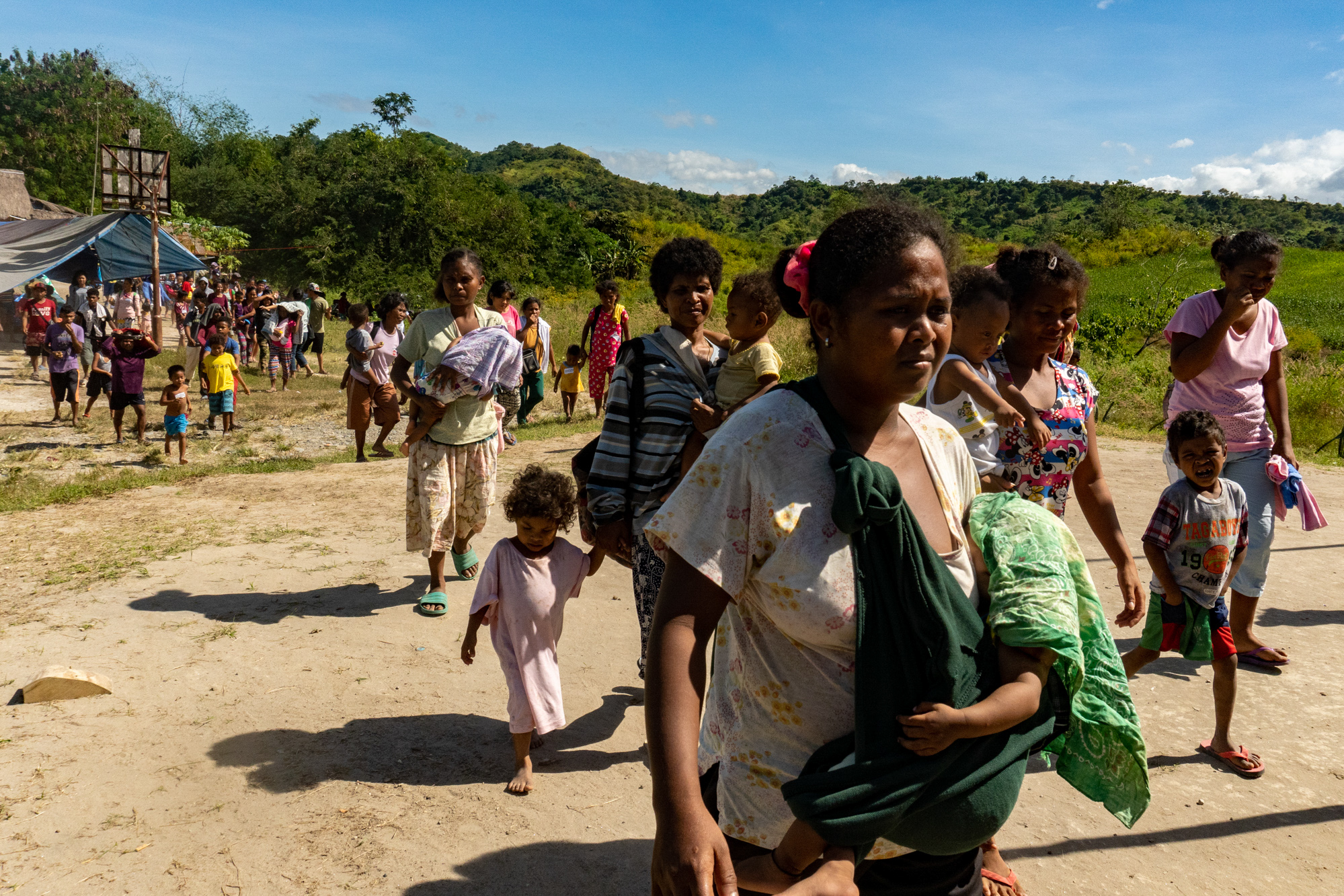
Apung Pet’s relatives arrive at Sapang Kawayan. All of her family and relative have rights to the land they inherited from their ancestors. Some 18,000 indigenous people who belong to the Aeta tribe may be displaced to make way for the construction of the New Clark City. Photo by Bernice Beltran.
The BCDA offers the affected communities some $5,900 per hectare of land and relocation sites, but did not disclose where the Aetas would move to.
Apung Pet said that some claimants who received the compensation from the BCDA are not from their clan and not from their ancestral territory.
“They only pretended that they are from here so they could receive financial assistance. I don’t even know who they are but I’m sure they’re not from here,” she explained.
“Once you spend the money, it’s gone. Our land is more valuable to us because it was given to us by our ancestors and we want the next generation to inherit it,” said 74-year-old Jose Capiz, Apung Pet’s older brother.
Old Blood
Growing up in Capas town, Jose knows his way around the hills like the back of his hand. Jose and his siblings are the clan’s “Aeta Hungey.” “Hungey” means “old blood” in the Aeta language. “Without our blood, the Aetas in Capas would not be alive today,” Jose said.
Being the “Hungey,” Apung Pet and her family are responsible for resolving conflict within the clan and overseeing the ancestral land. “Anyone who wishes to farm and build their homes within our land must ask permission from our family,” Apung Pet said.

A relative greets Apung Pet. Though her aunt is older, it is customary among the Aetas to greet the “hungey” or the old blood by taking the hungey’s hand and placing it on the forehead. Photo by Bernice Beltran.
“We are not squatters. When our ancestors first came to Capas, they named all the places you can find in this land. They named this village Sapang (stream) Kawayan (bamboo) because they saw abundant bamboo trees along the stream,” the tribal leader said.
“Sapang Kawayan, Patling, Malutong Gabun, Cutcut, Oyangoren – these are just a few places whose names were given by our ancestors. Outsiders could not pronounce Oyangoreng so it became ‘Aranguren,’” she said.
When the news about the tribal displacement broke, the BCDA published a statement regarding the seven-day notice for evacuation.
In the statement posted on their website last December 5, 2019, the BCDA said that consultations were made with the local government. Apung Pet said she was never included in the conversation.
Life in Sapang Kawayan
In Sapang Kawayan, Jose planted corn, rice, and sweet potatoes in a plot of land near his hut. His harvests were sold in the markets in Capas.
Though he makes decent money, he worries about his wife, 64-year-old Corazon Capiz who was paralyzed after suffering from a stroke four years ago.
Despite her condition, Corazon made herself useful. She set up a small convenience store in her hut selling drinks, snacks, and cigarettes, which Jose buys from the market in Capas.

Jose Capiz helps his wife Corazon lay down on her cot. After having a stroke four years ago, Corazon made herself useful buy setting up a small convenience store where she sold snacks and drinks. Photo by Bernice Beltran.
Unable to move the left side of her body, Corazon sits on her cot all day. The cot was placed beside the makeshift shop, where the items were displayed on shelves attached to a window with a small opening.
Customers would peek through and hand her money through the opening. When she gets tired, Jose would help her lay down.
“I don’t know how I would survive outside Sapang Kawayan. I can’t work at my age now and with this condition,” Corazon said.
Jose and Corazon’s 12 children have already left Sapang Kawayan to work. All of them are married, blessing the couple with 45 grandchildren and great-grandchildren.
“If we leave this place, what will I give to my children and grandchildren?” Jose lamented. Though his children and grandchildren have moved out, Jose said that they are entitled to the land as Aeta Hungeys.
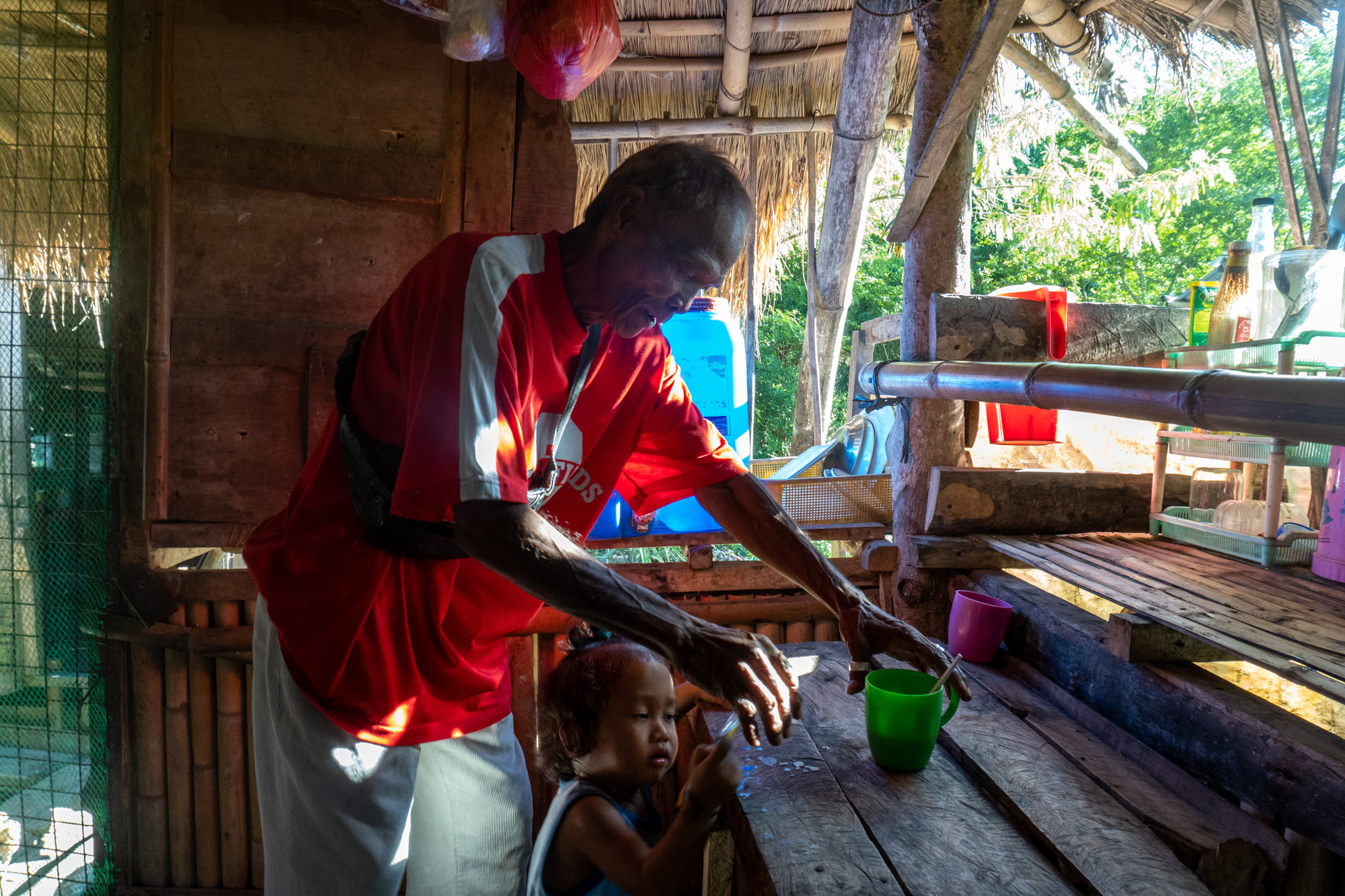
Jose Capiz looks after his great-grandson, Prince, in his home in Sapang Kawayan. Photo by Bernice Beltran.
Jose never dreamed of living in the city. “It’s not the life that my family and I are used to,” he said. “I didn’t finish school, so how will I work in the city?”
What concerns Jose the most is the way city-dwellers treat the Aetas. “People from the city look down on us. They cover their noses as if disgusted by the sight of an Aeta.”
Jose also feels that the city is not a safe place to live, saying that “there are a lot of thieves.” In Sapang Kawayan, he could walk for hours in the mountains and trust his neighbors to look after his house and his family.
“Will the government be able to provide us land where my children and grandchildren could farm and live the way we do now? Will that place be as safe as Sapang Kawayan?” Jose wondered.
“If there are opportunities and relocation sites for the Aetas, we wanted to know what and where these would be,” he added.
In Sapang Kawayan, the Capiz clan is well-respected. Apart from the livelihood, the Aetas consider the land sacred since their parents and ancestors are buried here.
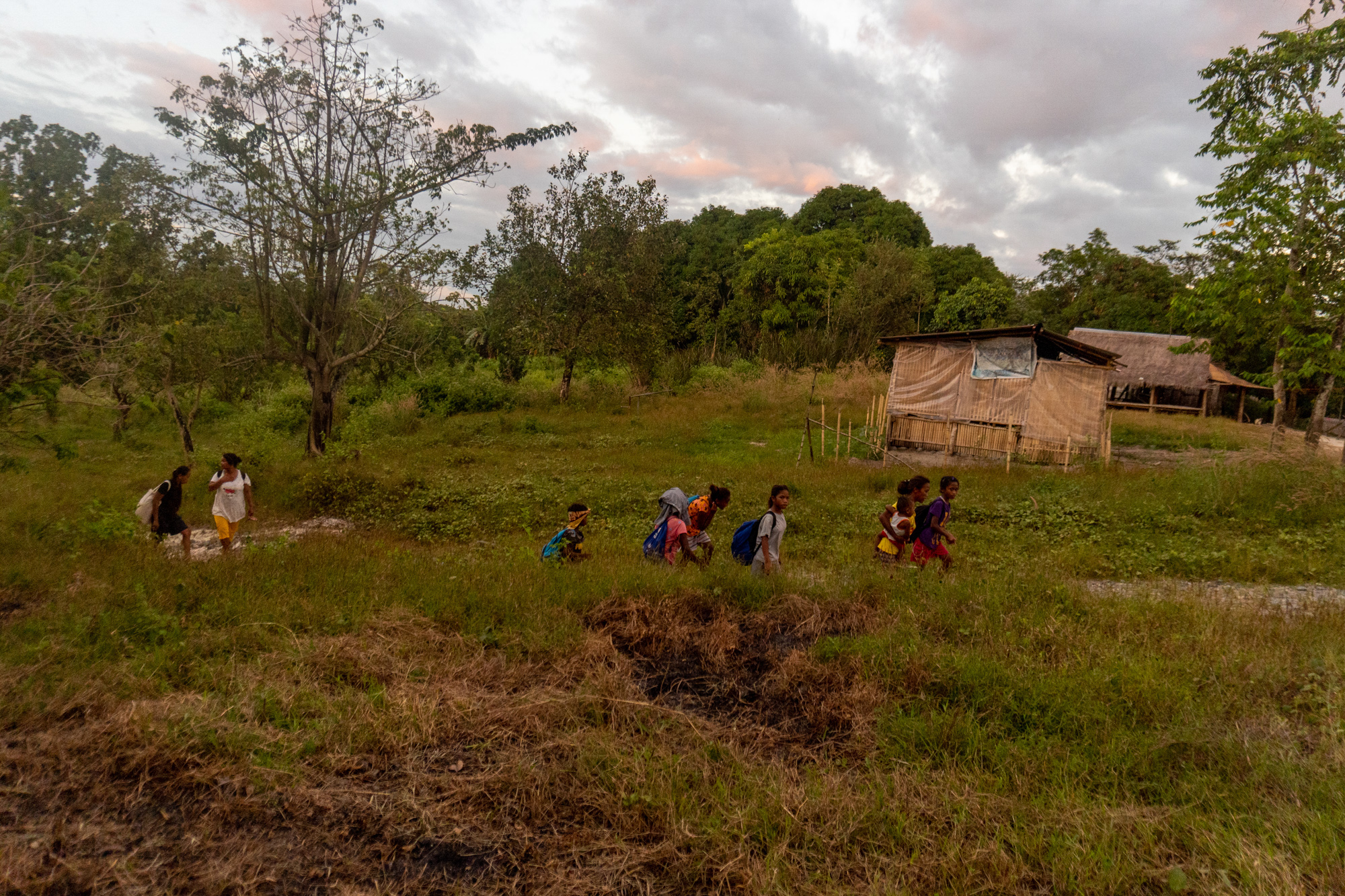
Relatives of the Capiz siblings arrive in Sapang Kawayan. Photo by Bernice Beltran.
We Are Filipinos, Too
Seven days passed since the Aetas received the notice to evacuate from BCDA. The community was scheduled to leave sometime in early to mid-December 2019, but no one came to evict them.
The BCDA did not respond after multiple follow-ups on a request for an interview.
With the help of human rights advocate and lawyer Attorney Antonio La Viña, the Aeta people responded to the government’s notice to evacuate.
In the letter dated December 5, 2019, La Viña reiterated that the former military base and reservation in Capas is an ancestral land and that the consent of the communities is needed before entering the land.
The communities can stay in their ancestral land, he argued, and must not be evicted without consent.
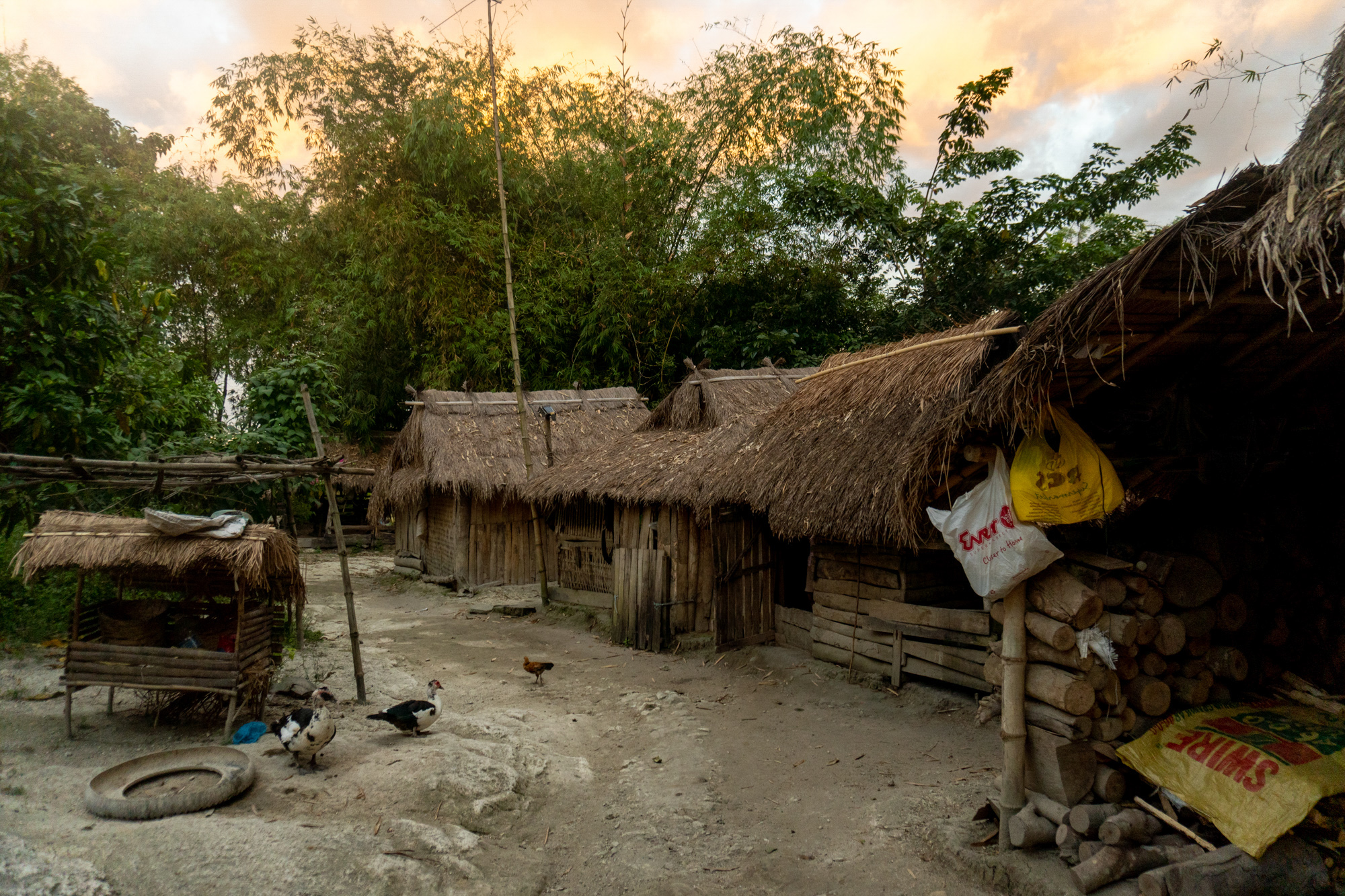
Wooden houses belonging to the Aetas in Sapang Kawayan in Capas, Tarlac. Photo by Bernice Beltran.
The lawyer attached documents proving that the Aetas were in fact in Capas long before the Americans set up bases and reservations in the Philippines.
One document was a report by the General Directorate for Civil Administration of the Spanish government in the Philippines, dated March 7, 1881.
The report aimed to inform the King of Spain that a Spanish missionary priest had successfully assembled some 50 families of Negrito Balugas or Aetas into a basic unit called a barrio.
“At the same time, I believe, it is my desire to tell Your Excellency, for the satisfaction of those interested, that the formation of the Barrio in the Capas Township, aside from its missionary, Fray Felix Perez, has been also effectively contributed by the immediate and present gobernardorcillios, Don Crispin Capis and Don Isabelo Mayuyo, with their repeated excursions to these mountain people who they continue verifying,” the report read.
As of writing this report, some of the mountains were already flattened as the project is set to be completed in December 2020.
Sapang Kawayan remains untouched, at least for now.
“We don’t know if the government would hear us out, but we will continue to fight, not with violence, but with principles,” Apung Pet said.
Echoing his sister’s words, Jose put up a sign by the dirt road leading to Sapang Kawayan. On a white tarpaulin, he hand-painted the words “Ipaglaban Ang Karapatang Pantao ng Aeta,” which means “Let’s Fight for the Aetas’ Rights.”
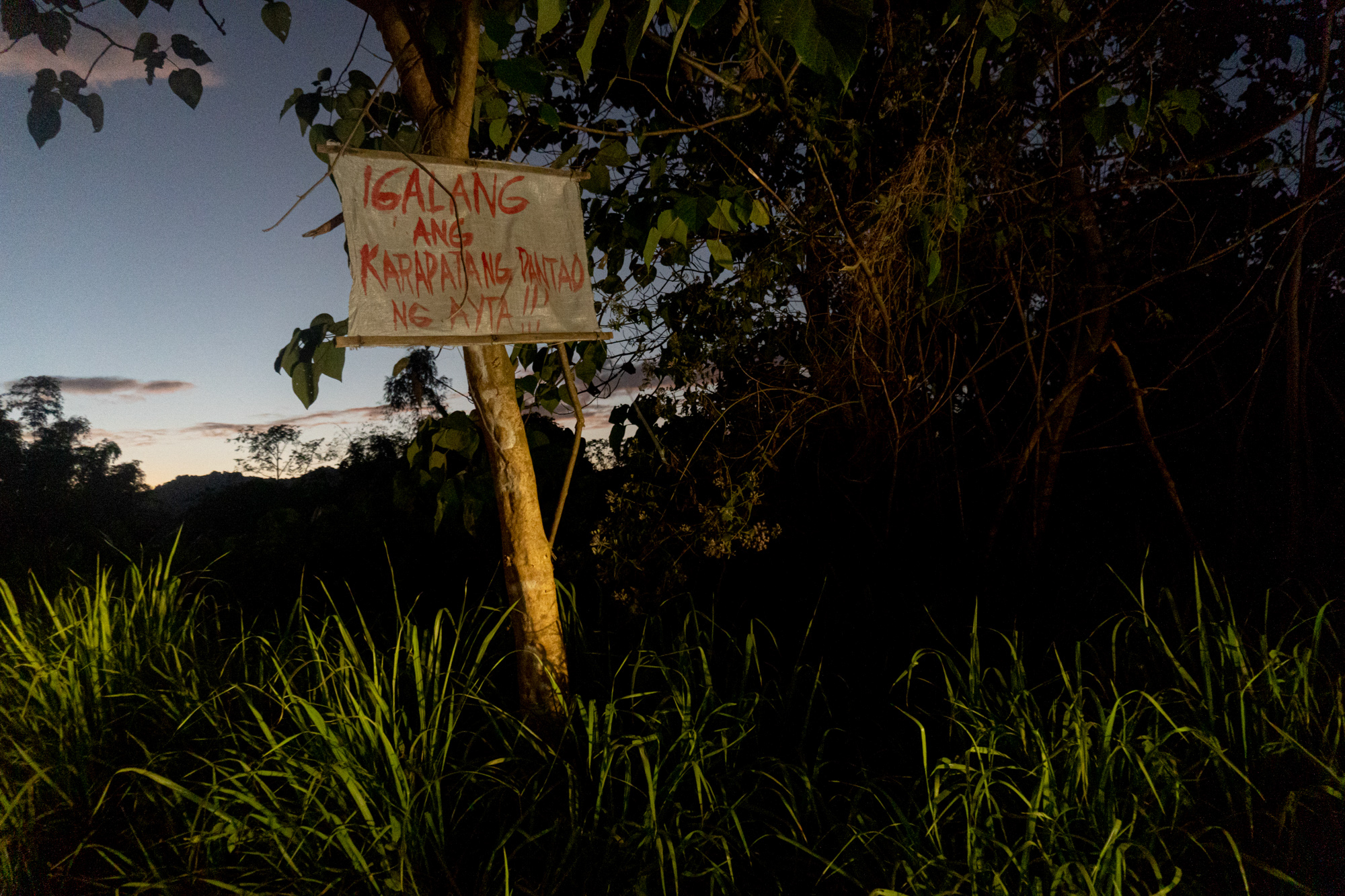
A sign by the dirt road in Capas, Tarlac reads “Respect the rights of the Aetas.” Photo by Bernice Beltran.
“We are not against a development project, especially if it would benefit many Filipinos, but we are Filipinos, too,” Apung Pet said.
“What makes it worse for the Aetas,” Apung Pet continued, “is that the foreign investors already entered the ancestral land without consulting the tribal elders.”
After almost two decades since the Aetas applied for the Certificate of Ancestral Domain Title (CADT), the National Commission for Indigenous Peoples (NCIP) still has not granted the title to the Aetas.
“NCIP’s inaction angers me,” Apung Pet said.
Before she became a chieftain, there had already been three tribal leaders who worked to obtain the CADT but all of them were unsuccessful despite submitting complete requirements.
“All we want is for the government to recognize our rights,” she added.
Bernice Beltran is a photographer and writer based in Manila.













